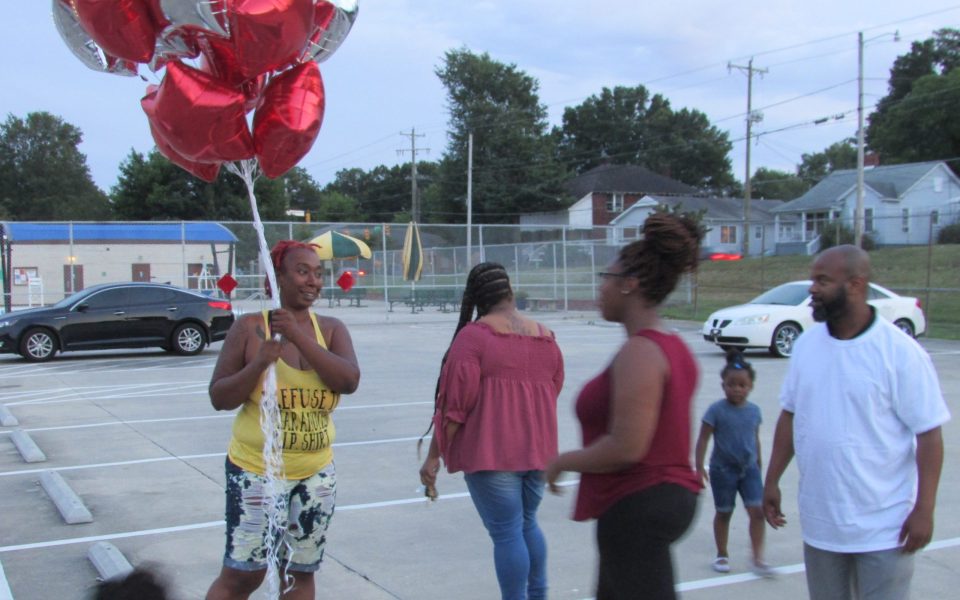Ingram Bell wore a yellow shirt declaring, “I refuse to wear another RIP shirt.” She held a clump of red and silver helium balloons, the kind that materialize during birthdays and graduations, as a small crowd gathered in the parking lot at the Windsor Recreation Center on Thursday evening.
“It’s a lot of families hurt,” she said. “It’s not just one family. When you lose a child, a brother, a sister, a mother, a friend, it’s not just us hurting. We’re also hurting those who have to go to jail because now we’re losing a father going to jail, a child going to jail, a sister going to jail. So it’s not just one side hurting. Everybody’s hurting. So I’m just asking everybody in Greensboro: Just cease fire. Put your guns down. Something else to do. Talk about it. Talk it out. Death is senseless.”
Three black men succumbed to gun violence in Greensboro on Monday. The stats — how this year’s body count stacks up compared to last year — are not that important. One death is too many. The vigils and press conferences are not new either. The rituals to commemorate lives unexpectedly cut short — the balloons released as the names of the dead are called out and the little votive candles flickering over the asphalt in the twilight — no one relishes this.
Grief is supposed to be a unique possession for the bereaved, but unfortunately the narrative is too relatable.
Tunya Crawford’s boyfriend, Darren Herbin, was one of those three men slain on Monday.
“I done heard a million stories between Monday and now,” she said during the vigil, “but until we get out here and do something about this — y’all — we’re gonna continue to come out here and light these candles…. And after Sunday, when I lay my guy to rest, everybody else [is] going back to their normal life.”
If this story is familiar, it bears repeating: Death steals something irreplaceable from family members.
“I had to call the sergeant to come and tell me that my son was deceased,” recalled Tonya Cuthbertson-McCrimmon, whose son, Ernest Lemark Cuthbertson, was slain in December 2015. “It destroyed my life, my trust in people. It destroyed my family’s life. It has changed tremendously. I tried to commit suicide in 2017. I isolate myself in my house. But I am surrounded and I have a very nice support system. I try to rebuild my life. I have nightmares. I have intense crying spells. I have trauma therapy that I go to. When these murders occur, I relive every single thing that happened to my son.”
Ingram Bell, the woman wearing the shirt that says, “I refuse to wear another RIP shirt,” said she can put herself in the shoes of the person who is angry enough to take another human being’s life. She sustained a gunshot to her head in 2011. She grew up knowing Darren Herbin, and went to talk to Tunya Crawford after learning of his death. Even though the program is not yet funded, Bell has taken on the role of “interruptor” under a model known as Cure Violence, which treats violence as a public health problem. People who are hurt and seeking revenge might not listen to a cop, a social worker or a pastor. Bell is what they call a “credible messenger.”
“I’ve been that angry person,” she says. “I have the ability to talk to people.”
Bell’s cousin, Starmecca Parham, who lost her brother, Sakwane Wray, in 2015, agreed.
“We have the community connection that we can have the conversations,” Bell added.
Parham, also an interruptor, said, “I’ve been on the other side where your emotions rage. Anger is a pretty basic feeling. Anger at yourself. You ask: ‘Why wasn’t I there to stop it?’ Anger with whoever you worship: ‘Why did you let this happen?’ You’re scrambled. What’s next? If I do something to that other family, what does that leave you with? A lot of pain and sorrow.”
Join the First Amendment Society, a membership that goes directly to funding TCB‘s newsroom.
We believe that reporting can save the world.
The TCB First Amendment Society recognizes the vital role of a free, unfettered press with a bundling of local experiences designed to build community, and unique engagements with our newsroom that will help you understand, and shape, local journalism’s critical role in uplifting the people in our cities.
All revenue goes directly into the newsroom as reporters’ salaries and freelance commissions.


Leave a Reply